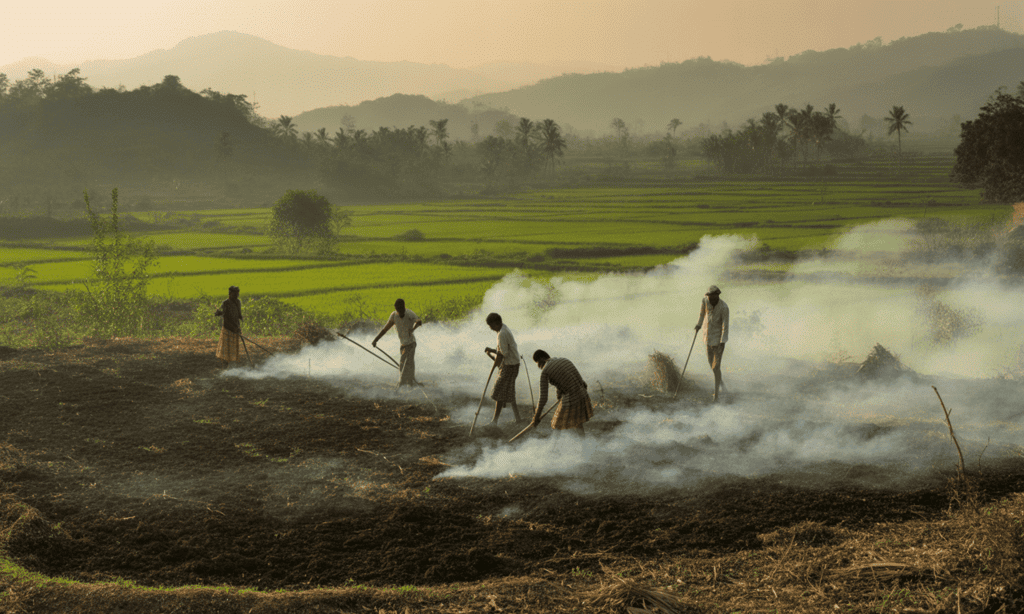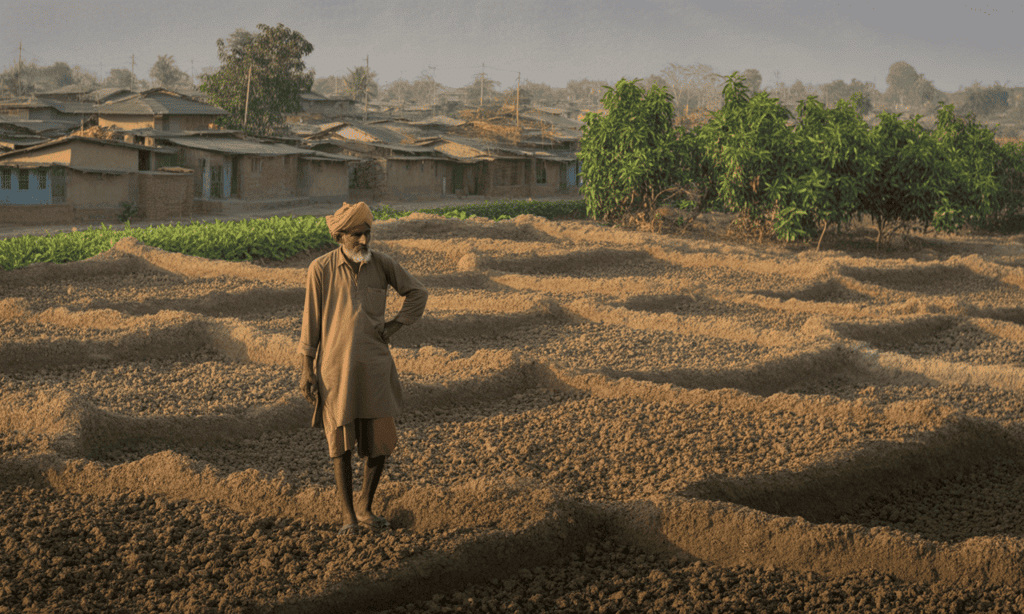Unit Test (Solutions): Agriculture | Social Studies (SST) Class 10 PDF Download
Time: 1 Hour
M.M.: 30
Instructions: Attempt all questions.
- Question numbers 1 to 5 carry 1 mark each.
- Question numbers 6 to 8 carry 2 marks each.
- Question numbers 9 to 11 carry 3 marks each.
- Question numbers 12 & 13 carry 5 marks each.
Q1. Which one of the following types of farming is known as 'slash and burn' agriculture?
a) Commercial Farming
b) Intensive Subsistence Farming
c) Primitive Subsistence Farming
d) Plantation Farming
Ans: c) Primitive Subsistence Farming
Primitive Subsistence Farming involves clearing land by slashing and burning, which is characteristic of this agricultural practice.

Q2. Which of the following is NOT a Rabi crop?
a) Wheat
b) Barley
c) Paddy
d) Mustard
Ans: c) Paddy
Paddy is a Kharif crop, grown during the monsoon season, unlike Rabi crops which are sown in winter.
Q3. Which one of the following is a major tea-producing state in India?
a) Gujarat
b) Assam
c) Rajasthan
d) Bihar
Ans: b) Assam
Assam is renowned for its tea production, contributing significantly to India's tea industry.
Q4. Which statement is true regarding the Green Revolution?
a) It focused on increasing forest cover in India.
b) It aimed to boost agricultural productivity using HYV seeds and modern inputs.
c) It was a campaign to promote organic farming.
d) It supported traditional farming methods without irrigation.
Ans: b) It aimed to boost agricultural productivity using HYV seeds and modern inputs.
The Green Revolution introduced high-yielding varieties and modern agricultural techniques to enhance food production.
Q5. Which one of the following is an example of a Kharif crop?
a) Gram
b) Maize
c) Peas
d) Barley
Ans: b) Maize
Maize is a Kharif crop, typically sown with the onset of the monsoon and harvested in the autumn.
Q6. State any two reasons for the pressure on agricultural land in India. (2 Marks)
Ans: Two main reasons for the pressure on agricultural land in India are:
- The division of land among generations due to inheritance, resulting in smaller landholdings.
- A lack of alternative livelihoods, which compels farmers to maximise output from their limited land.

Q7. Mention any two advantages of the Green Revolution in India. (2 Marks)
Ans: Advantages of the Green Revolution in India:
- Increased agricultural productivity: Significant rise in the production of key crops like wheat and rice.
- Improved food security: Enhanced food grain production, ensuring better availability of food.
Q8. State any two features of plantation farming. (2 Marks)
Ans: Two features of plantation farming are as follows:
- Single Crop Cultivation: Plantation farming focuses on growing a single crop over large areas.
- Capital-Intensive: This method relies on significant financial investment and migrant labour, with the produce primarily serving as raw materials for industries.
Q9. Explain the differences between Rabi, Kharif, and Zaid cropping seasons in India. (3 Marks)
Ans: India has three main cropping seasons:
Rabi Season:
- Sown in winter (October to December).
- Harvested in summer (April to June).
- Key crops include wheat, barley, peas, gram, and mustard.
- Primarily grown in northern states like Punjab, Haryana, and Uttar Pradesh.
Kharif Season:
- Begins with the monsoon (June to September).
- Harvested in September-October.
- Important crops are paddy, maize, jowar, and cotton.
- Regions include Assam, West Bengal, and coastal areas of Odisha.
Zaid Season:
- A short summer season between Rabi and Kharif.
- Crops include watermelon, muskmelon, and cucumber.
- Focuses on vegetables and fodder crops.
Q10. Explain the concept of intensive subsistence farming and its significance in India. (3 Marks)
Ans: Intensive subsistence farming is a method that relies heavily on labour and uses significant amounts of biochemical inputs and irrigation to maximise output from small plots of land. This approach is particularly important in India for several reasons:
- It addresses the high population pressure on limited arable land.
- Farmers can achieve higher yields to meet food demands.
- It contributes to food security in rural areas despite small farm sizes.
Q11. What are the consequences of the decline in soil fertility in primitive subsistence farming? (3 Marks)
Ans: Consequences of the decline in soil fertility in primitive subsistence farming are as follows:
- Reduced Productivity: Low soil fertility results in decreased crop yields, which affects food availability.
- Shifting Cultivation: Farmers often abandon infertile land, leading to deforestation and environmental harm.
- Economic Strain: Lower productivity reduces farmers' income, which can perpetuate poverty and limit access to modern farming inputs.
Q12. Describe the major factors responsible for the success of rice cultivation in Punjab and Haryana. Suggest measures to sustain rice production in these states. (5 Marks)
Ans: Factors for Success:
- Irrigation Infrastructure: A well-developed network of canal irrigation and tubewells provides essential water supply, especially in areas with low rainfall.
- High-Yielding Variety (HYV) Seeds: The introduction of HYV seeds during the Green Revolution significantly boosted rice production.
- Fertile Soils: The alluvial soils found in the Ganga-Satluj plains are ideal for rice cultivation.
- Modern Inputs: The use of chemical fertilizers, pesticides, and mechanised farming techniques enhances productivity.
- Government Support: Policies like minimum support prices and procurement initiatives encourage farmers to grow rice.
Measures to Sustain Production:
- Implement sustainable irrigation practices to avoid depleting water resources.
- Encourage crop rotation with pulses to preserve soil health.
- Provide subsidies for environmentally friendly inputs, such as organic fertilizers.
- Invest in research for developing drought-resistant rice varieties.
- Educate farmers on water-saving techniques, including drip irrigation.
Q13. Discuss the importance of pulses in Indian agriculture. Choose any two pulse crops, describe their growing conditions, and explain the steps taken by the government to promote pulse production. (5 Marks)
Ans: Importance of Pulses:
- Pulses are a key source of protein in vegetarian diets, essential for nutritional security.
- As leguminous crops (except arhar), they fix nitrogen in the soil, improving fertility and aiding in crop rotation.
- India is the largest producer and consumer of pulses, making them vital for food security.
Pulse Crops and Growing Conditions:
- Tur (Arhar): A Kharif crop that thrives in warm temperatures (20–30°C) and requires moderate rainfall (60–100 cm). It is typically grown in well-drained soils in states like Madhya Pradesh and Maharashtra.
- Gram: A Rabi crop that prefers cooler weather (15–25°C) and low rainfall (40–60 cm). It grows well in black and alluvial soils, mainly in Uttar Pradesh and Rajasthan.
Government Steps for Promotion:
- Introduced minimum support prices to ensure fair returns for farmers.
- Provided subsidies on pulse seeds and fertilizers through initiatives like the National Food Security Mission.
- Established cooperative societies and Grameen banks for low-interest loans.
- Promoted pulse cultivation through agricultural programs on radio and television.
- Conducted research and distributed high-yielding pulse varieties to enhance productivity.
|
66 videos|614 docs|79 tests
|
FAQs on Unit Test (Solutions): Agriculture - Social Studies (SST) Class 10
| 1. What are the main types of agriculture discussed in the syllabus for Class 10? |  |
| 2. How does climate influence agricultural practices? |  |
| 3. What are some common challenges faced in agriculture today? |  |
| 4. What role does technology play in modern agriculture? |  |
| 5. Why is sustainable agriculture important and what practices contribute to it? |  |
















